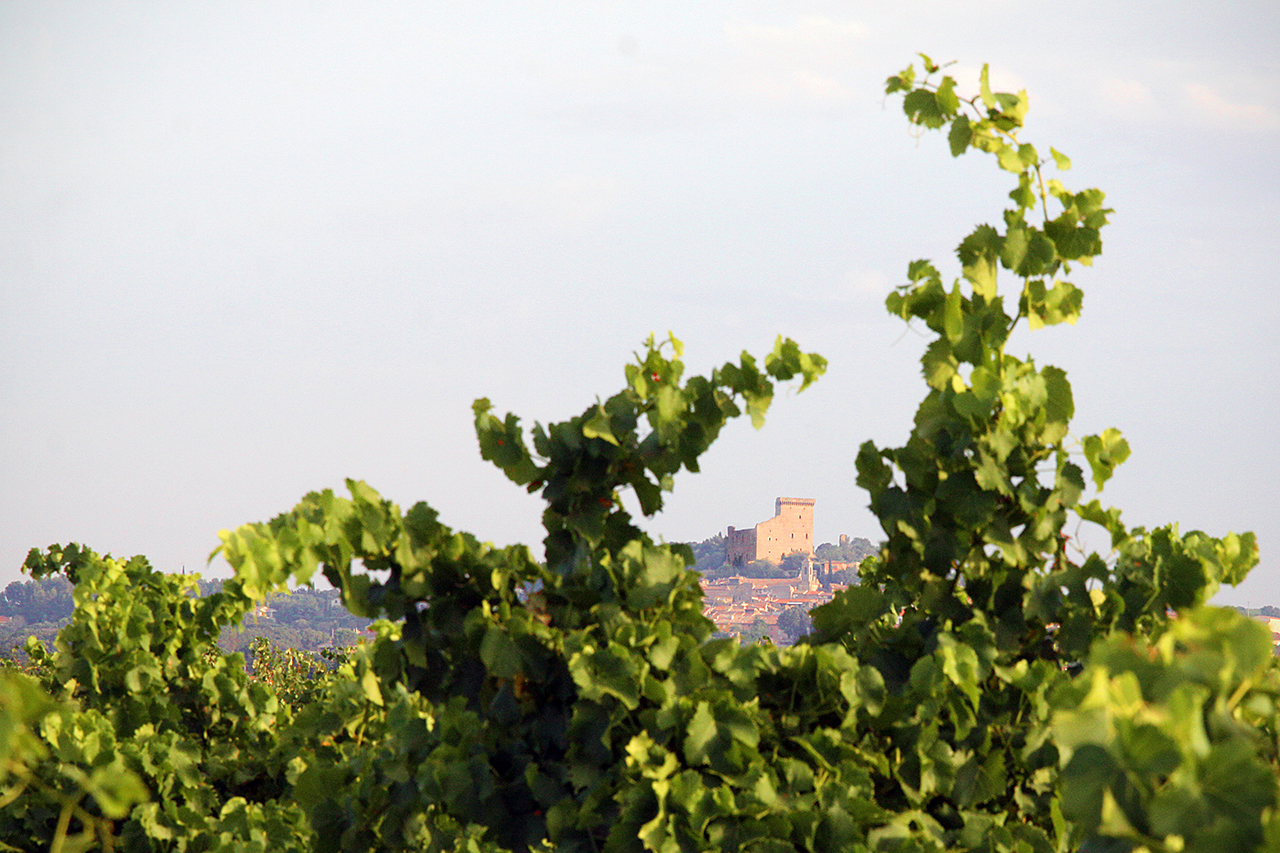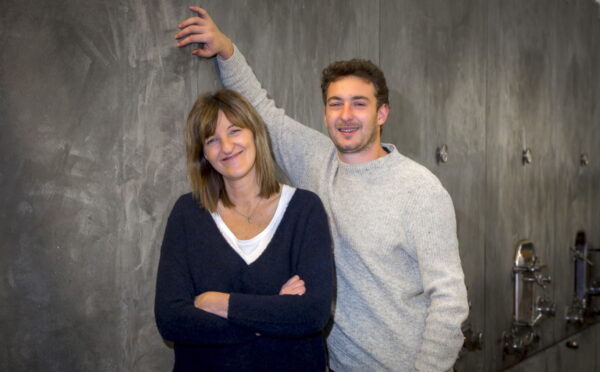


View of the village of Châteauneuf-du-Pape from Les Gallimardes. The Armeniers and Girauds are cousins, so at one time, their grandparents controlled a significant part of this terroir.
by Steven Spanbauer
Despite being a region noted for its diversity of permitted varieties, in reality, the performance of Grenache largely defines the reputation of a Châteauneuf-du-Pape vintage. For this reason, you will find vintage reports devote much attention to discussing the flowering of Grenache, the subsequent fruit set, the yields, and its harvest date. This is great for those who seek the purity of ripe, concentrated Grenache in their Châteauneuf-du-Papes, or those who value typicity over idiosyncrasy. However, it often leaves out those who might appreciate the character that blending can bring to the table.
Grenache buds early so that its subsequent flowering occurs when spring storms in the Southern Rhône, while infrequent, are not uncommon. The wrong storm at the wrong time means a drastic reduction in the yields for Grenache skewing blended cuvées in different directions based on the relatively higher proportions of Syrah and Mourvèdre. Any excessive rain in the summer wrecks havoc with the thin skins of Grenache, resulting in diligent vineyard work and crop thinning. Several growers have reported that climate change isn’t so much about hot and dry conditions but inconsistent weather punctuated with more freakish storms.
What has become a trend in the last decade are vintages where Grenache fairs poorly while Syrah and Mourvèdre excels. Hence, if your preference is for Châteauneuf-du-Pape with lower alcohol, dark fruit character, more earth, and funk, then vintages like 2018, 2014, 2013, and 2011 are the wines for you. 2019, 2016, 2015, 2012, and 2010 are vintages for those who appreciate the richer and fleshier style.
So here is our take on the last several vintages with the attendant focus on Grenache balanced with fair treatment for Syrah and Mourvèdre.
This is part of a series of articles originally published in 2021 and updated in April 2022 and November 2022. The other posts in this series are: Châteauneuf-du-Pape, a primer of sorts, Châteauneuf-du-Pape, the red varieties, and Châteauneuf-du-Pape, the white varieties. This is a regularly updated post, so if you’re a fan of Châteauneuf-du-Pape and our growers, bookmark this post.
The consensus on the 2021 vintage is that there cannot be a consensus. While the devastating frosts that drastically reduced yields in Northern France also occurred in the South, they were not as thoroughly damaging. The mid-elevation villages between those appellations bordering the Rhône and higher-elevation sites near the Dentelles seemed to have been impacted more. But even in Châteauneuf-du-Pape, where yields are off 20%, the areas affected by frost were scattered across the appellation. Christophe Sabon reported a 45% reduction in yield while Sophie at Domaine Marcoux reported a 30% loss of crop mainly concentrated in the southern part of the appellation:
The vines had grown from about 20 to 30 cm in many places, sometimes less, but almost everything froze, especially in the southern districts: Gallimardes, Jolijean, Pigeonne… – Sophie Armenier, Domaine de Marcoux

Sophie Armenier and her son Vincent Estevenin.
The more significant influence on the vintage was a cool, rainy growing season, barely tempered by a few short heat spikes. Usually, late harvests in Châteaneuf would be a welcome departure from recent trends. Unfortunately, the skies opened up in mid-September, with 4 inches of rain falling right in the midst of harvest. Early-ripening Syrah, what little survived the frost, was already largely harvested, but growers faced a difficult decision with Grenache. Either they took the potential risk of dilution and disease and waited, or they rushed harvest, risking less than full ripeness. Those who waited benefitted from strong winds that dried the vines and prevented rot. Patience rewarded those who waited as well as properties with higher percentages of Mourvèdre such as Janasse, Sabon, and Mourre du Tendre. Overall, there are comparisons to the more recent 2013 & 2014 vintages, which for those who like a darker character and more moderate alcohol levels, should find much to like.
In the end, we have a late vintage, atypical, which takes us back a few years, a little more on the freshness than usual, wines which will be appreciated a little younger but with a good aging potential thanks to beautiful acidities. – Sophie Armenier
The vintage presents with good acidity (the PH are a little lower than average) which gives a nice lift to the wines balanced with alcohols around 14.5 % vol. We practiced long macerations with gentle extractions, to obtain rich wines with beautiful length and freshness. – Didier Négron, Domaine Roger Sabon
The 2021 vintage in the South of the Rhône is a real return to the classic vintages from before the 2000s. Vintages during which you have to take risks to give birth to great wines. – Julien Brechet, Domaine des Bosquets
Patience rewarded those who waited as well as properties with higher percentages of Mourvèdre such as Janasse, Sabon, and Mourre du Tendre. Overall, there are comparisons to the more recent 2013 & 2014 vintages, which for those who like a darker character and more moderate alcohol levels, should find much to like.
The smallest crop in many years with reductions in yield between 25-45%. An approachable vintage with a lively Grenache expression that will reward decanting or a few years aging. Exceptional vintage for whites and Mourvèdre.
2020 was an exceptionally unusual vintage for Grenache. While the prevailing conditions were hot and dry, 2020 lacked the lengthier periods of extreme heat experienced in 2019, and Grenache was very slow to reach full physiological ripeness. Luckily some light rains towards the end of September hastened the ripening, with the last grapes being picked in early October. The final alcohol levels were lower in 2020 than in 2019, the tannins are more delicate, and the fruit character is more inclined to red fruit rather than black or blue fruit. Unlike vintages where Grenache suffered from coulure, 2020 doesn’t have a pronounced shift to the dark, earthy flavor profile of Syrah and Mourvèdre. Rather its hallmark is a harmoniously fresh, balanced, and engaging fruit-forward expression where Grenache is light on its feet, and any contribution of Syrah and Mourvédre adds floral and garrigue-laced complexity.
Pronounced red-fruit Grenache character with delicate tannin. Syrah & Mourvèdre in perfect balance. A fresh, fruit-forward vintage to be enjoyed upon release.
This was an ideal vintage for Grenache, an abundant fruit set followed by three heat waves interspersed with rain and more moderate temperatures. As a result, there was no heat stress for the vines, and ripening never shut down for a significant period. Harvest was surprisingly prolonged despite the heat of summer, allowing growers to pick at what they felt was the optimum ripeness and around a few showers late in the season. As difficult as 2018 was, 2019 was a dream vintage since almost nothing had to be done in the vineyard. The fruit’s health carried through to the cellar, with many growers reporting that their vinifications (mostly indigenous yeast ferments) were fast and efficient. Some growers reported small berries and thicker skins than normal, with some challenges to tannin management.
Strong Grenache character with greater than normal tannin. Syrah & Mourvèdre more in the background.
What is often called a vintage made in the vineyard because of all the work it took to bring in a crop, 2018 is favored by many of our growers more than critics, probably because they worked so hard to make it happen. With rain in May and June, there was both a poor fruit set for Grenache coupled with the threat of mildew. Our organic vignerons grew frustrated that their treatments were continually washed away by un-forecasted rain. Many reported a 40%-60% reduction in their Grenache. Syrah and Mourvèdre fared better, and these varieties are quite pronounced in the blends.
Lighter Grenache footprint, more red fruit contribution. Pretty and delicate Grenache-only cuvées. When in the blend, Syrah stands out at the moment, contributing a high-toned floral note and earthy minerality.
The vintage started with frost at the end of April, followed by a dry summer. This impacted Grenache more than other varieties since it buds earlier. Then in May, the region was hit with inclement weather, further reducing the Grenache yields. Some of our growers reported a greater yield reduction in 2017 than in 2018 in the range of 25-50%. Luckily summer was hot and dry, allowing the crop to ripen uniformly with a long harvesting period at a leisurely pace. So beneficial was this warmer period later in the season that the remaining Grenache was quite healthy. Didier Negron observed that this vintage was like a more concentrated 2014.
Grenache is more apparent than in similar vintages like 2014. When tasted in January 2020, many wines with Mourvèdre in the blends have a distinct leather, herbal edge to their darker and sweeter fruit. Overall, richer and darker in style than 2018 but with the same lithe character.
Hailed by many as a dream vintage because the Grenache was only minimally impacted with difficulties at flowering followed by a summer of perfect weather. Hot and sunny during the day but dry enough that evening temperatures were refreshingly cool. This was a great summer for tourists as well as grapes. This is a remarkably age-worthy and balanced vintage with plenty of structure.
A very structured Grenache vintage with smaller berries and thicker skins. Perhaps a little more backward than 2019 at the same point of evolution. When tasted in January 2020, the 2016s were just beginning to show a touch of fresh black truffle in their aromas but still retained much of their primary fruit and freshness.